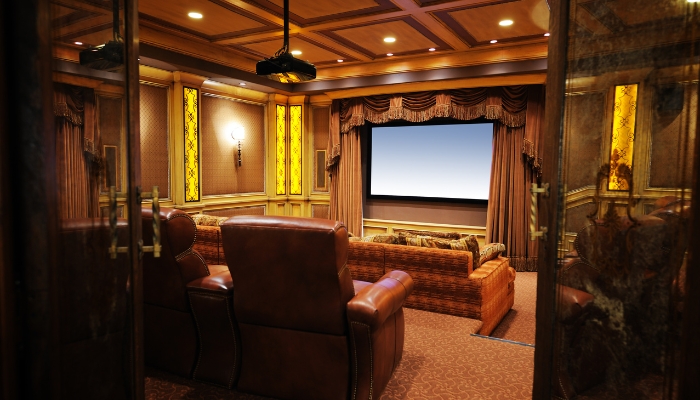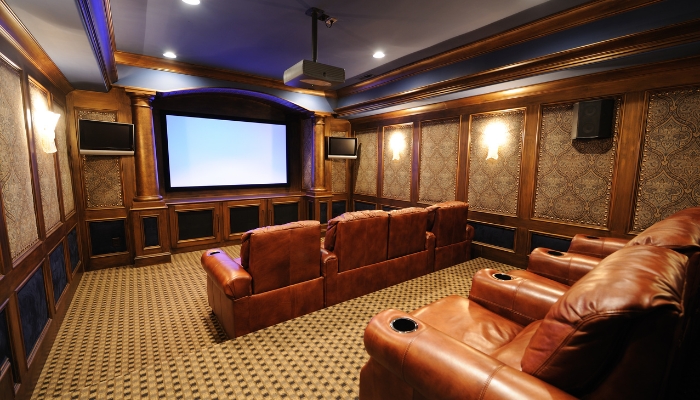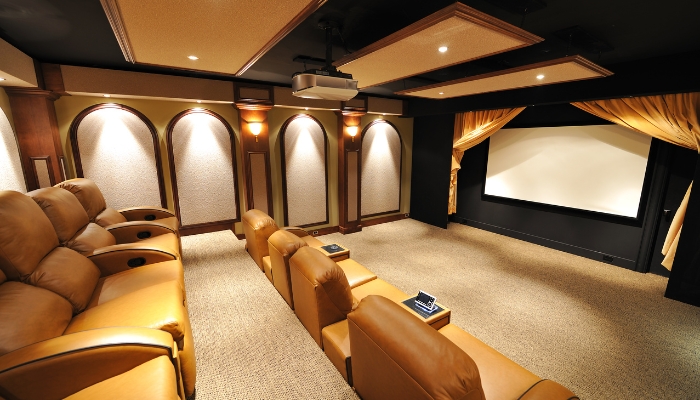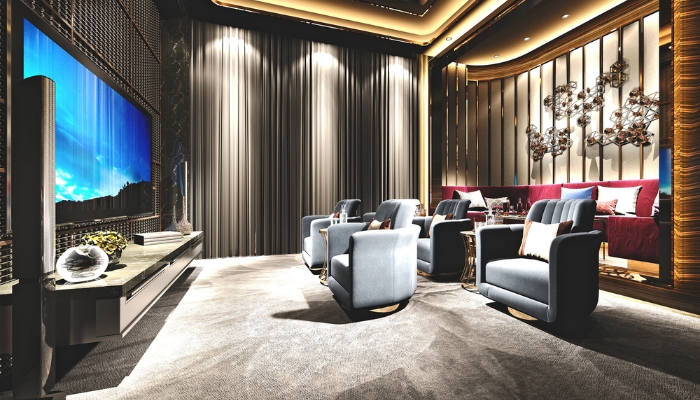We've officially started 2023, and the year is bright with possibilities — especially with your home theater! And what better time than now to finally create the ultimate viewing room you keep dreaming about?
But what actually goes into a home theater? Lots of things, but don't sweat the small stuff. We'll review the essential items you need to create the best home theater experience!
1. The Right Display

When it comes to home theater displays, bigger is always better! A 4K home projector will give you a cinematic experience as if you were in an actual movie theater. Home projectors need enough distance for the best setup, so they should be mounted in the middle or back of the room in the ceiling or on a shelf. But you can also place the projector in a hidden floor console!
And if you want to take it a step further, you can have a 4K UHD TV display for regular viewing and a projector with a drop-down screen that you use for special movie nights!
Pro Tip: Talk to your integrator about the best option for your home theater. They'll also figure out the ideal placement for all your viewing components.
2. Speakers

Ahh, yes, the most crucial part of any home theater — the speakers! There are several speaker types that should definitely be included in your setup, from the front speakers to the surrounds!
- Front Left/Right Speakers: handle all the background music and special effects.
- Center Speakers: locks in the dialogue and primary vocals on the screen for every listening position.
- Surround Speakers: reproduce backfield sound effects and are typically positioned on side walls just behind the primary seating around ear level about 6ft. off the floor
- Subwoofers: are vital for capturing extremely low frequencies, so you never miss a beat.
- Front Height/Width Speakers: expands on the height or width of the soundstage, like with Dolby Atmos.
Don't forget about Dolby Atmos-enabled speakers! Dolby places each individual sound or audio object in a 3-D soundscape so that you can hear sound in a virtual bubble (including left, right, front, behind, and overhead!).
Pro Tip: If you prefer having hidden speakers so you can focus on the style of your home theater, mention it to your local integrator!
3. Great Acoustics
The one thing you should never skip out on is treating your room with acoustics — they can increase speaker performance up to 75 percent! This means ensuring the space is isolated from outside noise, reducing interior echo, and dampening high frequencies that can cause a harsh sound. That way, you'll feel surrounded by all the action.
Some acoustic treatments include absorbers, diffusers, and bass traps, but the types of treatment you need will depend on the size of the room and whether there is carpeting.
Pro Tip: Treating a room is labor intensive and requires a lot of steps — leave it to your custom integrators instead!
4. Source Components

Having quality sources to feed your display is just as important, so don't forget to consider these in your list. Source components include your satellite/cable box, a 4K Blu-ray player, streaming devices, or music sources like turntables. Whichever options you have, you'll want to consider where to place them, like hidden behind a panel or in a tasteful cabinet — the choice is yours!
5. Receivers
On top of your display, speakers, and source components, the next vital component is your receiver, which decodes and amplifies digital audio sources to playback through your speakers. These receivers connect your speakers, video input, and display device together for a flawless viewing experience.
But some of the best receivers will also function as an amplifier. However, depending on your home theater setup, you can always add separate amplifiers and preamps.
Pro Tip: High-performance installations will have a separate sound processor and power amplifier. Your customer integrators will know what your system needs!
6. Lighting

Another essential aspect of your home theater experience is the lighting. Go too heavy, and you'll deal with glare, but if you don't have enough, no one will be able to see to get to their seats. But with careful placement, you can create the perfect mood to make it feel like an actual movie theater!
However, if you plan to have projectors, the darker the room is, the better, so think about having automated lighting that you can program to dim pre- and post-viewing and turn off when your source material starts playing — just like at the movies!
7. Seating

What's a home theater without comfortable seating? Now, the seating can be anything you want. You can choose home theater seating that actually looks like movie theater seats, complete with cupholders and recline. Some even feature built-in lighting, USB charging, power reclining, side tables, armrest storage, heated seating, or even massage!
But you can also change up the look with stylish modular seating that matches the rest of your home.
Happy Viewing!
Now that we've gone over the essential elements of a home theater setup, all that's left to do is get started at Automation Design & Entertainment! Believe us when we say it will be worth the effort —nothing beats having a movie-theater experience every day!
So, contact us today, and we'll set you up with your consultation appointment. We'll go over what you want your home theater to look like and provide you with plenty of options!